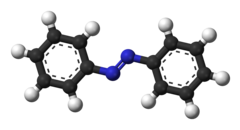Azobenzene
 |
|
 |
|
| Names | |
|---|---|
|
IUPAC name
(E)-Diphenyldiazene
|
|
| Other names
Azobenzene
|
|
| Identifiers | |
|
3D model (Jmol)
|
|
| ChEBI | |
| ChemSpider | |
| ECHA InfoCard | 100.002.820 |
| KEGG | |
|
PubChem CID
|
|
| RTECS number | CN1400000 |
| UNII | |
|
|
|
|
| Properties | |
| C12H10N2 | |
| Molar mass | 182.23 g·mol−1 |
| Appearance | orange-red crystals |
| Density | 1.09 g/cm3, solid |
| Melting point | 69 °C (156 °F; 342 K) |
| Boiling point | 293 °C (559 °F; 566 K) |
| 6.4mg/L (25 °C) | |
| Acidity (pKa) | 3.3 |
| -106.8·10−6 cm3/mol | |
| Structure | |
| sp2 at N | |
| 0 D (trans isomer) | |
| Hazards | |
| Main hazards | toxic |
| R-phrases | 45-20/22-48/22-50/53-68 |
| S-phrases | 53-45-60-61 |
| Flash point | 476 °C (889 °F; 749 K) |
| Related compounds | |
|
Related compounds
|
Nitrosobenzene aniline |
|
Except where otherwise noted, data are given for materials in their standard state (at 25 °C [77 °F], 100 kPa).
|
|
|
|
|
| Infobox references | |
Azobenzene is a chemical compound composed of two phenyl rings linked by a N=N double bond. It is the simplest example of an aryl azo compound. The term 'azobenzene' or simply 'azo' is often used to refer to a wide class of molecules that share the core azobenzene structure, with different chemical functional groups extending from the phenyl rings. These azo compounds are considered as derivatives of diazene (diimide), and are sometimes referred to as 'diazenes'. The diazenes absorb light strongly and are used as dyes in a variety of industries.
Azobenzene was first described by Eilhard Mitscherlich in 1834. Azobenzene was investigated in 1856 by Alfred Nobel as "gelblich-rote krystallinische Blättchen" ("yellowish-red crystalline flakes" in German). Its original preparation is similar to the modern one. According to the 1858 method, nitrobenzene is reduced by iron filings in the presence of acetic acid. In the modern synthesis, zinc is the reductant in the presence of a base.
One of the most intriguing properties of azobenzene (and derivatives) is the photoisomerization of trans and cis isomers. The two isomers can be switched with particular wavelengths of light: ultraviolet light, which corresponds to the energy gap of the π-π* (S2 state) transition, for trans-to-cis conversion, and blue light, which is equivalent to that of the n-π* (S1 state) transition, for cis-to-trans isomerization. For a variety of reasons, the cis isomer is less stable than the trans (for instance, it has a distorted configuration and is less delocalized than the trans configuration). The trans isomer is more stable by approximately 50 kJ/mol, and the barrier to isomerization in the ground state is approximately 100 kJ/mol.
...
Wikipedia
